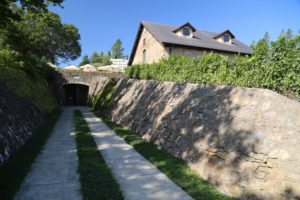
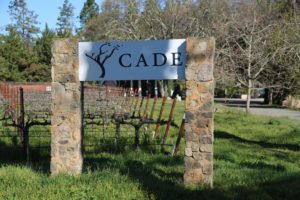
 13th Vineyard by CADE. In September 2016 The PlumpJack Group purchased what was Ladera Winery and vineyards on Howell Mountain. The three principals in the Plumpjack Group include businessman and philanthropist Gordon Getty, former mayor of San Francisco Gavin Newsom and General Manager, John Conover. In addition to this property, they currently own three other winery properties in the Napa Valley including Plumpjack in Oakville, Odette Estate in the Stags Leap District and CADE Estate Winery.
13th Vineyard by CADE. In September 2016 The PlumpJack Group purchased what was Ladera Winery and vineyards on Howell Mountain. The three principals in the Plumpjack Group include businessman and philanthropist Gordon Getty, former mayor of San Francisco Gavin Newsom and General Manager, John Conover. In addition to this property, they currently own three other winery properties in the Napa Valley including Plumpjack in Oakville, Odette Estate in the Stags Leap District and CADE Estate Winery.
As the crow flies, this winery is only about 1/2 mile from the original CADE Estate Winery. The property is planted to 86 acres of vines, the majority being to Cabernet Sauvignon with smaller amounts of Merlot, Petit Verdot, Malbec and Sauvignon Blanc. The first vintage from the estate bottled under the CADE label is from 2016. As of 2017, they began working towards fully organic certification of the vineyards (approximately a 3-year process).
Since the acquisition the winery has been outfitted to serve their own wine making needs with additional tanks (small and large added). Their production is around 13,000 cases but with the additional vineyards on site and space inside the winery, they plan to grow to approximately 20,000 cases. Despite about 1/2 of the CADE wines being Sauvignon Blanc, this winery is only used to make red wines.
The property is richly endowed with an intriguing historical wine pedigree and has seen a number of changes over the years depending on ownership. The original founders Jean Adolphe Brun and Jean Victor Chaix, both from France came to Napa Valley in 1874. Jean came with his brother Adrienne Pierre Chaix; Adrienne’s great grandchildren John and Kathy would start their own wine brand Chaix Wines in 2008. Brun had served in the Franco-Prussian War of 1870.
Both men met while working at Groezinger’s Cellar in Yountville and become good friends and then business partners. They formed a company called Brun & Chaix. Together they founded a winery in Oakville in 1877 called Nouveau Médoc Winery which was California’s 9th bonded winery; the site currently houses Napa Wine Company.
In 1877 they were among the first to plant grapes on Howell Mountain and called the vineyard site of what is now CADE at 13th Vineyard, the Nouveau Medoc Vineyard. According to an article in The St. Helena Star dated Friday, December 22, 1882 the Brun & Chaix Howell Mountain property totaled 191 acres; in 1880 the partners cleared 20 acres and planted the land to grapes. In 1882 they planted another 40 acres of vines. The same article mentioned 20 acres were planted to grains which was going to be cut and used for hay. By the late 1880s the property was planted to 115 acres of grapes, a sizable vineyard for a mountain site in Napa Valley at that time. Mr. Chaix was described as a pioneer grape grower on Howell Mountain.
In the early years of their grape production Napa Valley endured a significant frost; this was in the spring of 1881. Other than two acres in a lower part of the property the temperatures were not cold enough to do much damage.
Not only did they own and operate Nouveau Médoc Winery in Oakville, but according to an article in the Napa Register dated Friday May 18, 1883, they also operated a cellar at Routier Station in Sacramento County.
Brun & Chaix built the stone winery on the property in 1886 using stone quarried from nearby Angwin; this was one of Napa Valley’s early gravity flow wineries and was California’s 13th bonded winery. CADE has appropriately paid homage to that bond number for this second CADE location. This winery still stands having survived ownership changes, earthquakes and the ever present threat of wildfires including in 1932 when two homes on the property were destroyed by fire.
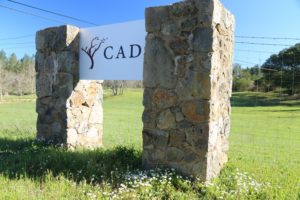
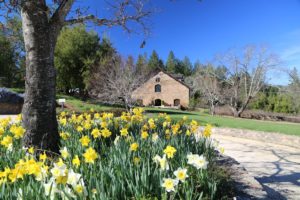 An article in The Napa Register dated Friday October 01, 1886 describes 100,000 cubic tons of soil and rock were removed to build the lower part of the cellar. Twenty men and 50 horses were being used to build the winery. The first ever crush on the property occurred this year including both purchased and estate grapes. This article also mentions 30 varieties of grapes were growing on the property that year. For several years, the Chaix family lived on the property.
An article in The Napa Register dated Friday October 01, 1886 describes 100,000 cubic tons of soil and rock were removed to build the lower part of the cellar. Twenty men and 50 horses were being used to build the winery. The first ever crush on the property occurred this year including both purchased and estate grapes. This article also mentions 30 varieties of grapes were growing on the property that year. For several years, the Chaix family lived on the property.
In an ingenious use of basic technology, those working in the winery used a large mirror on nearby “signal hill” to communicate to Napa Wine Co far down in the valley when it was time to pick the grapes so they would have advance notice of when they would need to prepare the crush pad for their arrival.
And noteworthy is an interesting twist of fate connected by geography some 130+ years later; Brun & Chaix first began their wine operations in Oakville, as did The Plumpjack Group with Plumpjack Winery, also in Oakville.
Even early on the vineyard proved itself in producing wines of excellence. By by mid 1880s Brun & Chaix had produced a wine that earned a bronze medal in the 1889 Paris World Competition (for Zinfandel). Their wines were sold in other parts of the country including in cities on the east coast; their wines were popular in New Orleans (especially their sweet Nouveau Médoc red) so they established an agency in that city. In 1900 they printed numerous lithographs of the property and distributed them to some of their sales agents to help promote their business. Even the St. Helena Star had a framed copy in their editorial office. Brun passed away in 1894.
Brun & Chaix incorporated in 1900; a year later it was reported by the Napa Journal in an article dated Tuesday, January 15, 1901 that John Chaix and Mrs. A Brun had sold all their stock in their wine business to a wine syndicate that had been recently organized, consisting of the California Wine Association, Lachman & Jacobi, C. Schilling & Co, The Italian-Swiss Colony, I. W. Hellman (president of Nevada Bank) and Antone Borel, a bander and Swiss Consul. The transaction included both the property on Howell Mountain and their winery in Oakville. The price for these holdings was $250,000. A year later Chaix passed at only age 50, leaving nine children and a widow.
In December 1908 an employee at Brun & Chaix on Howell Mountain (Peter Frederickson) met his untimely demise while driving a 4-horse drawn wagon filled with grain on the Howell Mountain grade. Rounding a bend the team of horses slid off the side of the mountain tumbling down the hillside killing both Frederickson and three of his horses. Remarkably an hour after this accident, another man named Henne, also driving a 4-house wagon team slid off the mountain at the same spot, tumbling down the hill for at least an estimated 60 feet. He was not seriously injured. He heard nearby grunts from the one living horse from the previous accident, climbed back up the hill and retrieved a lantern from a nearby farm house and returned to the scene of the accidents where he discovered Frederickson’s lifeless body among the horses.
Brun’s son Louis took a job in their Oakville winery in 1906. The California Wine Association took full ownership of the business in 1916.
In 1920, the first harvest following prohibition, it was reported that up to 400,000 gallons of sacramental wine were produced at their winery in Oakville, now under ownership of the California Wine Association. Although Reverend James P. Cantwell, Chancellor of the San Francisco Archdiocese later took great offense at what he called exaggerated production numbers. The Covick Company of San Francisco was responsible for the distribution of these wines. Brun & Chaix was one of the few wineries in Napa Valley to produce sacramental wines – others being Beaulieu Vineyard and Beringer Vineyards.
And in 1924 the name Brun & Chaix ceased to exist; the company was sold and its name changed to the Covick Company.
In 1919, the former Brun & Chaix Howell Mountain property was purchased by Giovanni Tripoli and was later referred to as Tripoli Winery. We haven’t yet located the exact date when he sold this property but it most likely was in 1943. Giovanni’s obituary in the Napa Register from 1953 indicated he produced sacramental wines here during prohibition.
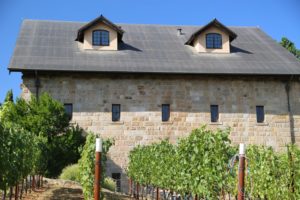
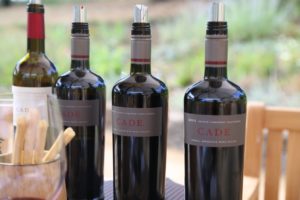 He and his wife Christina had one son Battista. Battista founded the Tripoli Center, on site of the complex that currently houses PRESS Restaurant. During its heyday, Tripoli Center housed Tripoli market, a nursery, a plumbing shop and a sheet metal store. Battista also established a Tripoli Market in Eureka, CA in 1949 before selling it in 1951 and moving his family back to Napa Valley.
He and his wife Christina had one son Battista. Battista founded the Tripoli Center, on site of the complex that currently houses PRESS Restaurant. During its heyday, Tripoli Center housed Tripoli market, a nursery, a plumbing shop and a sheet metal store. Battista also established a Tripoli Market in Eureka, CA in 1949 before selling it in 1951 and moving his family back to Napa Valley.
In the 1950s, Orville Nelson lived on the former Brun & Chaix Howell Mountain property. Orville was one of the owners of the Hilltop Food Market and Hilltop Service Station in Angwin, president of the Angwin Chamber of Commerce and Chief of the Angwin Fire Department. In the 1960s the property was known as the Noonan Ranch (L.F. Noonan).
In 1980, Francis and Françoise DeWavrin-Woltner who at one point held a sizable interest in Chateau La Mission Haut-Brion in Bordeaux and a stake in Napa’s Conn Creek Winery, purchased the property and replanted much of the vineyard to Chardonnay. Winemaker Ted Lemon, the founder of Littorai Vineyards produced several of their vintages int he late 1980s and early 1990s. The Woltner’s sold some of the grapes to other wineries including Napa’s Titus Vineyards who made a vineyard designate wine of this variety. The DeWavrin-Woltners renamed the winery to Chateau Woltner and produced their first vintage in 1985, remodeled the old winery and operated it until they sold to Pat and Anne Stotesbery in 2000, the founders of Ladera Winery. Prior to the sale, the DeWavrin-Woltner’s daughter, Frederique Dewavrin had been overseeing the operations.
The Stotesbery’s had caves drilled on site; these are located underneath the winery and run underneath one of the small vineyard blocks. The caves are approximately 16,000 square feet.
The grounds are gorgeous especially in mid spring featuring flowers, lawns and beautifully landscaped garden paths surrounding the winery. For visitors, the focus is on highly personalized experiences. The property features a diversity of locations for tastings including inside the cave, a tasting room inside the winery or outdoors among the gardens. And guests can purchase an enjoy bottles of wine on site.
The experience here is tailored towards tasting Library wines focusing on vintages of CADE Reserve Cabernet Sauvignon, Howell Mountain wines. Visitors may also request a tasting of the current release CADE Estate wines.
Select Wines
Sauvignon Blanc
The 2020 CADE Estate Sauvignon Blanc, Oakville is 43% Sauvignon Blanc, 42% Sauvignon Blanc Musqué Clone, 14% Semillon and 1% Viognier. This wine is medium straw in color; the bouquet offers bright citrusy aromatics including orange blossom, lime/lemon zest, some mineralities, a light flinty/steely character, lemongrass and pomelo. Smelling and tasting this on an unusually frigid and rainy first day of Spring, made us dream of only thing only – wishing we were sipping this by a pool on a warm summer afternoon in Napa Valley. From its bright and fresh scents, one would think this would be an acidic zinger on the palate. Its not. Rather it shows a very balanced acidity complemented nicely by a light rounded mouth feel. It offers flavors of green apple and some citrus notes. This is not a super ripe Napa Valley more tropical showing of this variety. It was fermented in 23% new French oak barrels, 30% in concrete eggs, and 47% in stainless steel drums. It was was aged sur lie for six months, blended and then finished aging in stainless steel barrels before bottling. It did not go through any malolactic fermentation.
The 2015 CADE Estate Sauvignon Blanc, Oakville is pale straw color in the glass leading one to perhaps think this is a lighter style of wine from this variety. Taking a closer look at this wine, one notices that it is not 100% varietal but rather is a blend of 57% Sauvignon Blanc Musqué, 37% Sauvignon Blanc, 5% Viognier and 1% Sémillon. The bouquet is appealing with aromas of citrus blossom, stone fruits including peach and tropical nuances. The wine is surprisingly rich with depth and weight on the palate. Creamy and rounded, with notes of apple and a lingering finish rich in terms of both fruit and texture. Drinks very well by itself.
Cabernet Sauvignon
The 2021 CADE Howell Mountain Estate Cabernet Sauvignon is 90% Cabernet Sauvignon, 6% Malbec and 4% Petit Verdot. This wine is deep ruby in color with a light amaranthine rim. On the bouquet, the aromas are floral and fruit driven; these include violets, lilacs, ripe blackberry, boysenberry jam, dark cherry with baking spices including clove and nutmeg. The generous palate offers a ripe but balanced showing of both this variety and this vintage in Napa Valley. It sports intense flavors of blackberry, boysenberry, mulberry, and dark cherry. This is a full expression of the variety. The grainy and gritty tannins continue to persist beyond the fruit on the finish. Oak is a lightly complementing character on both the bouquet and the palate; the star of the show here is clearly the fruit. In terms of being a crowd friendly, this wine delivers in spades in that regard.
During one visit to the property, we tasted a library vertical of Estate Howell Mountain Cabernet Sauvignon from vintages 2009 through 2011. All these bottlings are 100% Cabernet Sauvignon; these are wines that are highly distinguishable from each other – all with their own character represented of their respective vintages, age and style. Each are highly appealing for different reasons. And in what is still a very novel concept in the Napa Valley for premium wines, CADE and PlumpJack bottle their premium wines in screwcaps, but with a ‘twist’. They actually bottle about 50% of these wines with cork and when customers purchase bottles – they receive wines bottled in both screwcap and cork.
The 2011 CADE Reserve Cabernet Sauvignon, Howell Mountain is another highly pleasing wine from a challenging vintage in Napa Valley that received less than stellar scores as a whole from wine critics. A hint of tobacco on the bouquet is complemented nicely by aromas of plum and blackberry. It is lighter in style then other CADE vintages we have tried; everything is nicely balanced on the plate. Shows dusty tannins on a clean finish. This wine is drinking very well six years after vintage. In general, a number of 2011s needed some time in bottle to show the grace that this vintage was ultimately capable of.
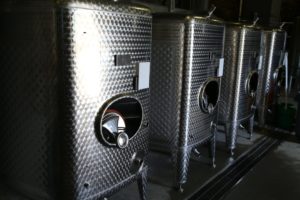
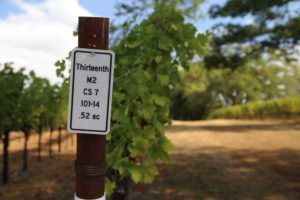 The 2010 CADE Reserve Cabernet Sauvignon, Howell Mountain offers a layered depth of aroma. Initially reveals darker berry fruit (boysenberry, blackberry) along with a sage component, black olive and chocolate. Shows a energetic brightness and liveliness of fruit on the palate supported by an accompanying acidity. This wine has more girth than the 2011 vintage, despite both years being on the colder and rainy side of the spectrum. And it still features a noticeable tannic grip on the finish after 7 years from the vintage date. Lingers with flavors of blueberry and a hint of toasted cedar.
The 2010 CADE Reserve Cabernet Sauvignon, Howell Mountain offers a layered depth of aroma. Initially reveals darker berry fruit (boysenberry, blackberry) along with a sage component, black olive and chocolate. Shows a energetic brightness and liveliness of fruit on the palate supported by an accompanying acidity. This wine has more girth than the 2011 vintage, despite both years being on the colder and rainy side of the spectrum. And it still features a noticeable tannic grip on the finish after 7 years from the vintage date. Lingers with flavors of blueberry and a hint of toasted cedar.
The 2009 CADE Reserve Cabernet Sauvignon, Howell Mountain shows a noticeable sweetness of fruit on the bouquet; this smells the ripest of the vintages we tried offering sweet berries including blackberry, dessert spice (molasses), ripe plum and black fig. This is a robust bottling yet also balanced on the palate. The tannins feel good in the mouth and are not harsh but rounded and fairly well integrated.
The 2006 CADE Estate Cabernet Sauvignon, Howell Mountain is a blend of 96% Cabernet Sauvignon and 4% Merlot. On the bouquet there are scents of black licorice and raspberry; in tandem these aromas are highly appealing. This wine offers dark fruit both on the bouquet and palate – including flavors of plum and black currant. Well structured but the lightly grippy tannins are integrated nicely with the supporting intensity of fruit.
The 2014 CADE Reserve Cabernet Sauvignon, Howell Mountain in its youth is built with bright berry aromatics including blackberry and blueberry with more subtle notes of dark chocolate. The palate is juicy, mouthwatering and big – deeply layered and well textured. Finishes with fairly robust and somewhat chewy mountain tannins. This is an exciting wine to drink now. Also, of the reds we tried, this was the only wine that was made by Danielle Cyrot; for reference, she joined the wine making team in 2012.
—
The property can be selectively rented for events; they work with Meadowood Resort to help cater the food portion of events. For more information, and to join their wine club or to request a private tasting, please visit: www.3thvineyard.com
Jean Adolph Brun, gravesite, St. Helena Public Cemetery

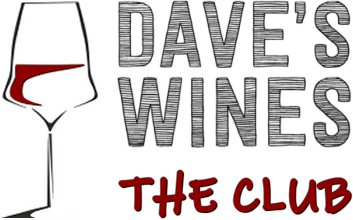





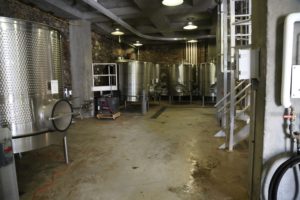
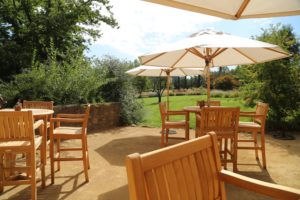
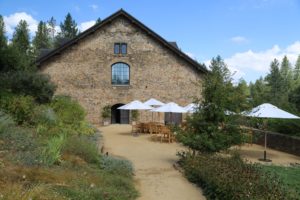
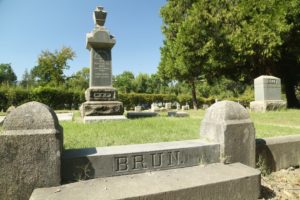
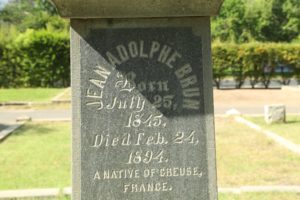
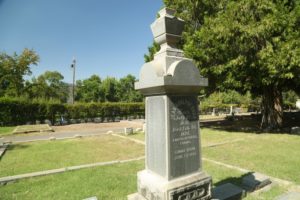
Leave a Reply